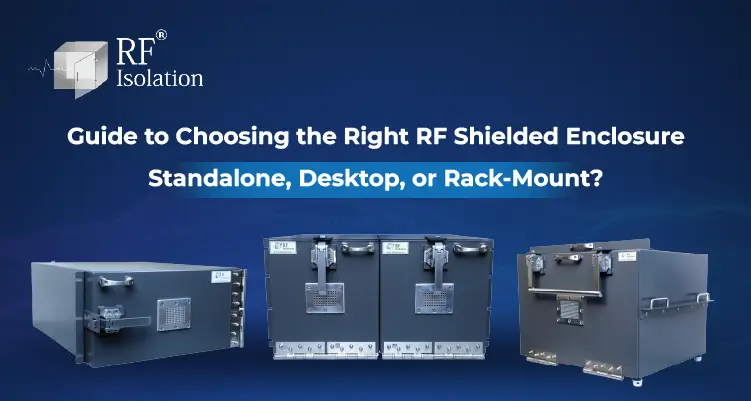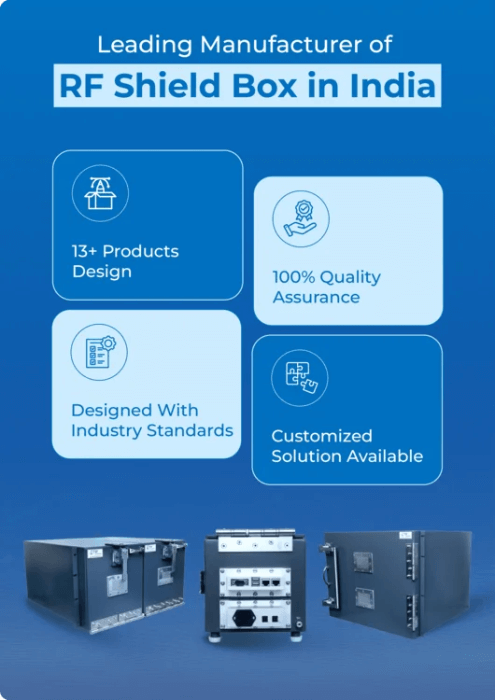
Guide to Choosing the Right RF Shielded Enclosure: Standalone, Desktop, or Rack‑Mount?
The right RF shielded enclosure can make or change your EMI/RFI testing accuracy. Whether you’re testing 5G devices, automotive electronics, or medical equipment, choosing between standalone, desktop, or rack-mount solutions directly impacts your testing efficiency, space utilization, and budget.
At RF Isolation, we’ve helped hundreds of R&D teams across automotive, telecom, and medical device industries optimize their RF testing setups. This complete guide simplifies exactly when to use each enclosure type and why it matters for your specific testing needs.
What Is RF Shielded Enclosures and Why Do They Matter?
RF shielded enclosures are specialized Faraday test enclosures designed to isolate electronic devices from external electromagnetic interference during testing. They create a controlled environment where your devices can be tested without wireless signals, cellular networks, or other RF interference affecting results.
These enclosures are useful for compliance testing, performance validation, and quality assurance across multiple industries. Without proper RF isolation, your test results may be compromised by ambient electromagnetic noise, leading to failed certifications or unreliable product performance.
The three main configurations—standalone, desktop, and rack-mount—each serve different testing scenarios, lab sizes, and workflow requirements.
Why Does RF Shielded Enclosure Type Matter for Your Testing?
Your enclosure choice directly affects testing accuracy, workflow efficiency, and long-term scalability. The wrong configuration can lead to delays in your testing process, wasted lab space, or insufficient isolation for sensitive measurements.
Consider these critical factors:
- Testing frequency and volume indicate whether you need portable or permanent solutions
- Lab space problems influence size and mounting options
- Device types and sizes affect internal chamber dimensions needed
- Integration requirements with existing test equipment and automation systems
Each enclosure type is effective in specific scenarios, making the selection process important for optimal ROI on your EMC testing investment.
When Should You Choose Standalone RF Shield Boxes?
Standalone RF shield boxes are ideal for flexible, multi-location testing environments and laboratories with changing requirements. These portable units offer maximum flexibility without permanent installation commitments.
Key Advantages of Standalone Enclosures
Portability and flexibility top the list of benefits. You can easily move these units between different testing stations, share them across multiple projects, or relocate them as your lab layout evolves.
Cost-effectiveness for smaller operations makes standalone boxes attractive for startups, research institutions, or companies just beginning their EMC testing programs. Initial investment is typically lower than rack-mount systems.
Easy setup and minimal infrastructure requirements mean you can start testing immediately without extensive lab modifications or specialized mounting equipment.
Ideal Use Cases for Standalone RF Shield Boxes
- R&D teams testing multiple device types across different projects
- Contract testing labs serving different clients with unique requirements
- Field testing scenarios where equipment needs to be transported
- Educational institutions conducting research across multiple departments
- Companies with limited dedicated lab space requiring flexible solutions
When Are Desktop RF Shield Enclosures the Right Choice?
Desktop RF shield enclosures are ideal in dedicated workstation environments where consistent, repeated testing occurs. These compact units integrate quickly into engineer workspaces while providing reliable RF isolation.
Benefits of Desktop RF Test Enclosures
Space efficiency in crowded labs allows engineers to maintain RF testing capabilities without sacrificing valuable bench space. These units typically occupy a minimal footprint while providing adequate testing volume.
Individual engineer accessibility enables multiple team members to conduct collaborative testing without resource conflicts. Each workstation can maintain independent testing capabilities.
Quick access and rapid testing cycles suit development environments where frequent device changes require immediate feedback. Engineers can quickly place devices, run tests, and repeat designs.
Best Applications for Desktop Enclosures
- IoT device development and designs requiring frequent testing iterations
- Bluetooth and WiFi module testing during component selection phases
- Small consumer electronics validation including wearables and smart devices
- University research labs conducting academic projects
- Quality control stations for production line testing
Why Choose Rack-Mount RF Shield Boxes?
Rack-mount RF shield boxes provide the highest level of integration, automation capability, and long-term scalability for professional testing environments. These systems integrate quickly into standard 19-inch equipment racks alongside other test instrumentation.
Advantages of Rack-Mount Solutions
Professional integration with existing test equipment creates streamlined workflows. Your RF enclosure becomes part of a large test system rather than a standalone component.
Enhanced automation capabilities enable unattended testing, batch processing, and integration with test management software. This hugely increases testing throughput while reducing manual intervention.
Superior EMI/RFI isolation often exceeds standalone units due to better grounding, improved sealing, and professional mounting systems. Critical for sensitive measurements and compliance testing.
Space optimization in professional labs maximizes testing capability per square foot of lab space. Vertical rack mounting preserves valuable bench real estate.
Optimal Use Cases for Rack-Mount Systems
- 5G and telecom infrastructure testing requiring high isolation levels
- Automotive electronics validation for ADAS systems and connectivity modules
- Medical device compliance testing where repeatability and documentation are critical
- Production line integration for automated quality control
- High-volume testing operations requiring maximum efficiency
| Feature | Standalone | Desktop | Rack-Mount |
|---|---|---|---|
| Portability | Excellent | Good | Limited |
| Initial Cost | Low-Medium | Low | Medium-High |
| Automation Integration | Basic | Limited | Excellent |
| EMI/RFI Isolation | Good | Good | Excellent |
| Space Efficiency | Variable | High | Excellent |
| Scalability | Limited | Medium | High |
| Professional Integration | Basic | Medium | Excellent |
| Setup Complexity | Minimal | Minimal | Moderate |
| Ideal Lab Size | Small-Medium | Any | Medium-Large |
| Testing Volume | Low-Medium | Low-Medium | High |
How Do You Choose the Right RF Enclosure Configuration?
Start by assessing your current testing requirements and future growth plans. The decision framework should consider both immediate needs and long-term laboratory evolution.
Evaluate Your Testing Requirements
Testing frequency and device types form the foundation of your decision. High-volume, repetitive testing favors rack-mount solutions, while occasional or variable testing suits standalone units.
Lab space constraints and layout flexibility influence mounting options. Permanent installations work well in dedicated facilities, while portable solutions suit shared or changing environments.
Integration needs with existing equipment determine connectivity requirements. Automated test systems benefit from rack-mount integration, while manual testing may only need basic connectivity.
Real-World Applications Across Industries
Automotive and EV Electronics Testing
Electric vehicle manufacturers like Tesla and traditional OEMs depend on rack-mount RF chambers for testing connectivity modules, ADAS sensors, and charging systems. These applications require consistent, repeatable testing with detailed documentation for regulatory compliance.
Desktop enclosures serve component validation during early development phases, while standalone units support field testing of installed systems.
Medical Device Development and Compliance
Pacemaker and implantable device manufacturers utilize rack-mount systems for FDA compliance testing, guaranteeing devices have the highest EMC requirements. The automation capabilities enable batch testing of multiple units with detailed data logging.
Portable standalone enclosures support clinical testing environments where devices must be validated in actual healthcare settings.
5G and Telecom Infrastructure
Network equipment manufacturers depend on rack-mount RF chambers for testing base station components, small cells, and massive MIMO systems. High isolation levels allow accurate measurement of sensitive parameters.
Desktop units serve R&D teams developing new protocols and components, while standalone boxes support field validation of deployed equipment.
IoT and Consumer Electronics
Smart device manufacturers often start with desktop enclosures for prototype testing, then scale to rack-mount systems for production validation. This progression supports company growth while maintaining quality assurance.
Standalone units provide flexibility for testing different product lines with varying form factors and testing requirements.
Custom RF Shielding Solutions: When Standard Options Aren't Enough
Sometimes your testing requirements exceed standard enclosure capabilities. RF Isolation specializes in customized RF shielding solutions according to unique device sizes, frequency ranges, or environmental conditions.
Custom solutions fix challenges like:
- Oversized devices requiring larger internal volumes
- Specialized frequency ranges needing optimized shielding materials
- Environmental testing integration combining RF isolation with temperature/humidity chambers
- Unique connectivity requirements for specialized test equipment interfaces
These solutions make sure your testing capabilities match your exact requirements rather than forcing compromises with standard products.
Conclusion
Selecting the right RF shielded enclosure—standalone, desktop, or rack-mount—directly impacts your testing accuracy and operational efficiency. Standalone units offer flexibility, desktop enclosures provide workspace integration, and rack-mount systems deliver professional automation capabilities.
RF Isolation specializes in helping R&D teams across automotive, telecom, and medical industries optimize their EMC testing setups. Our customized solutions guarantee your RF shielding matches your exact requirements.
Ready to upgrade your testing capabilities? Contact RF Isolation for expert guidance on choosing the perfect enclosure package for your laboratory needs. Visit rfisolation.in to explore our complete range of RF shielding solutions.

